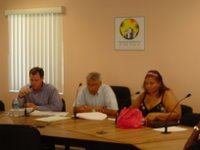Working with Residents:
Working with residents in planning the redevelopment is discussed in Sections C.1. Scope of Services and C.2 Lead Developer’s Role:
Under C.1. it says: It is expected that the Lead Developer and his/her planning and design team members will work with HACS, residents and other interested parties to develop site plans through an open planning process with participation by residents, neighbors and other interested stakeholders.
Under C.2. it says: The Lead Developer will be required to work in partnership with HACS, current residents and other neighborhood and local organizations to design and implement each Redevelopment Plan and under the list of services the developer is to provide the RFP says Collaborate with HACS and the residents to implement a general management structure for the development that includes a long term role for the residents. The developer is required to ensure resident involvement throughout the planning and implementation of the project, and Develop and implement a M/WBE and a Section 3 program in conjunction with life skills training, contracting and apprenticeship for resident ownership and participation in the development process.
Under Section D.4, Content of RFP Response, Respondents have to provide Public Housing Resident Participation, Minority and Public Housing Resident Equity/Contracting Participation, and relocation plans. All of these requirements are factored into the scoring of the RFP responses as discussed under Section E.2
Providing Social Services :
Included in the list of services to be provided by the developer under C.2 is Work with HACS to fund and coordinate on-going community and supportive services for public housing residents at the redeveloped sites.
Section D.4 requires a Community and Supportive Services Plan that requires Respondents to Describe proposed Community and Supportive Services Plan for current residents of HACS Newton developments. Provide specific examples of similar work undertaken by the Respondent’s team at other developments. This plan is part of the scoring criteria in Section D.4.
Also, at the 6/12 meeting with the RFQ/RFP Evaluation Committee, we discussed with Valerie adding language to the description of the Section D.4 Relocation Plan to be provide in the responses regarding an MOA with residents. We’ll include such language in the next draft circulated to the committee.
Number of PH units :
Bonus points are to be awarded for the inclusion of more PH units in Respondents’ proposals (see Sections B.1, B.3 and E.2.) At the 6/12 meeting we discussed adding a 10 point sliding scale for bonus points for proposals that provide for more PH units. That language will be added to the next draft.
Ultimately, the number of PH units will be determined by the maximum number that is financially feasible within the context of good design. The Advisory Committee that approved the conceptual site plans decided that a total of 852 units in 2 and 3 story buildings was the optimum number of units that could be developed. Additional units would require taller buildings and greater density, which the Committee, which received input from the community, did not feel was in the best interests of the public housing residents or the surrounding community nor financially feasible.
The mix of public housing, non-public housing affordable and market rate units to be built on the site is a function of both policy and financially feasibility (especially as no federal funding is available for these sites and state funding is very competitive). The conceptual site planning effort sought to maximize affordability while proposing a financially feasible unit mix based on conservative financing, market and land use assumptions. The number of units and mix of units proposed by RFP Respondents may vary from the conceptual site plans based on what the developers think is financially feasible and good design. Scoring of the RFP responses, as discussed in Section E.2., is to be based primarily on financial feasibility, the number of affordable units (with bonus points for PH units), and quality of site planning and design.
Building Heights, Storm Water Retention, Community/Open Space:
Taller, elevatored buildings are more expensive to build due to a variety of building code, construction material and design issues, and that additional cost does affect financial feasibility. In addition, the Advisory Committee, did not think it good policy, good planning or financially feasible to include mixed income family units in mid-rise buildings on these sites, so the conceptual site plans incorporated elevator buildings only for Senior units. (In addition, the Committee also felt that it would be more difficult to obtain County and City financial support and site plan approvals to build mid-rise family buildings.)
More land may be available for development if developers find they do not need to set aside as large a portion of the site for water retention as we have conservatively estimated to be the case. As stated in Section B.1 of the RFP, The portion of each Development Site set aside for surface storm water retention was an estimate. Respondents may propose the amount of land for surface storm water retention, or alternative water retention systems, as they deem to be appropriate and in accordance with Southwest Florida Water Management District regulations for storm water management.
The conceptual site plans included community space at each site within each site’s management and leasing building (the next draft of the RFP will be clearer on what was incorporated in the conceptual). Any land designated for community facilities and open space comes at the expense of residential units. The Advisory Committee decided on the balance of community space/open space and residential units shown in the conceptual plans with the goal of maximizing the number of units. The RFP Respondents may propose additional community space and open in their plans based on marketing/financing and planning considerations, and those proposals will be evaluated based on the RFP’s scoring criteria.
[Submitted by Brian Heegar, consultant to HASC]


